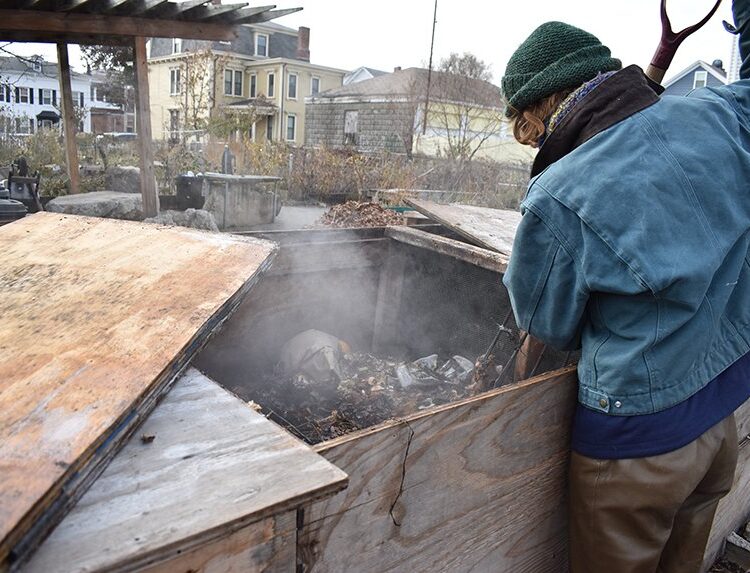‘There is an emerging marine science and tech cluster in the South Coast and the Rhode Island area. We want to support that.’
This story was originally published in The New Bedford Light, a publication partner of Ocean State Stories.
NEW BEDFORD, Mass. — The state’s alternative-energy development agency has chosen a waterfront spot for a center devoted to ocean-related power research, building and field-testing equipment, and cultivating new enterprises.
The Massachusetts Clean Energy Center wants to lease less than half an acre from the New Bedford Port Authority on MacArthur Boulevard encompassing the 19th-century Bourne Counting House and a parking area next to it.
The stone structure would provide office and meeting space. A portion of the parking lot is slated for a new structure for building prototypes for ocean-related energy technology — chiefly, but not exclusively, wind power.
“This project is an exciting new opportunity for New Bedford to develop technology businesses, generate new demand for existing businesses, and elevate its stature as a leader in maritime industries,” Mayor Jon Mitchell wrote in a letter to the City Council, sending along a proposed 15-year lease for consideration this week.

Mitchell wrote that the center — to be established next to Merrill’s restaurant, across MacArthur Boulevard from the Fairfield Inn & Suites — “will establish a platform on which marine technology of all types can be developed and commercialized into new businesses.” He said it will also serve as a meeting point for industry conferences.
“There is an emerging marine science and tech cluster in the South Coast and the Rhode Island area. We want to support that,” said Bruce Carlisle, managing director of offshore wind for MassCEC. “This will expand New Bedford’s role around ocean renewable energy and ocean climate tech.”
Carlisle said early this year that because New Bedford is becoming a center of the offshore wind industry, it made sense as a spot for the Ocean Renewable Energy Innovation Center. He said then that the project would enhance the city’s role in the industry and be part of the state’s effort to reduce carbon emissions to curb climate change.
“New Bedford has a tremendous amount of infrastructure, marine services, and a deep water port,” Carlisle said. “We believe that, if we are going to lean into an innovation center, it should be in New Bedford.”
Carlisle has estimated that the center will cost about $1.5 million a year to operate, likely supported by a mix of federal funds, corporate sponsorships, and lease payments from main tenants.
He said earlier this year that the center is meant to eventually accommodate about two dozen startup companies at full capacity and five to eight industry partners. He added that the industry partners likely won’t have their main offices in the center, but will instead use the center for their research and development teams.
In an interview with The Light on Monday, Mayor Mitchell spoke of the importance of broadening the scope of industries on the Port of New Bedford. While previous investment has focused on physical jobs related to the offshore wind industry, the center is among the first projects that expand into the creative and innovative spaces of the clean-energy industry.
“When it comes to the maritime industries, we want to be a city of both big shoulders and big brains,” Mitchell said. “There is a tremendous amount of pent-up knowledge and know-how here in New Bedford. A place like this that enables researchers and corporations to put their heads together will create greater efficiencies and great new ideas and businesses to emerge.”
The CEC’s schedule calls for work on the project to begin early next year and operations starting in the summer of 2026. The state has allocated $15 million for the venture, including $10 million from federal American Rescue Plan Act funds.
“We have built out a great deal of the port over the last few years,” Mitchell said. “We also need a place where new innovation is materialized and commercialized so that we can continue to have a competitive edge over other ports.”
The project includes no costs for the city, Mitchell says. Starting next January, the city is due to collect $38,000 a year in lease payments, adjustable annually to changes in the Consumer Price Index. That’s equal to the sum the Port Authority — which is expected to vote on the lease on Sept. 24 — receives in parking fees from the site, the mayor’s letter says.
“This is all upside for New Bedford,” Mitchell said. “In the best-case scenario, this becomes a national leader in innovation that competes against similar facilities being built elsewhere, like in Brooklyn. In the worst-case scenario, if it doesn’t succeed, the city gets the building at the end of the lease term.”
Merrill’s restaurant is expected to stay open, and the Ground Floor coffee shop and catering business are expected to continue operations in the counting house, also known as the Merrill’s Wharf Building. The hotel and the restaurant, which use the parking lot, will be accommodated with parking across the street at the old Eversource site, Mitchell’s letter says.
A CEC summary of the project prepared for the City Council this month says the site was chosen from an original list of seven prospects, winnowed to five. The agency issued a 100-page report on the venture last December, and put out a request for information on potential sites early this year.
The agency originally said they were looking for building space at least 37,000 square feet within a quarter-mile of the waterfront.
“You can open a coworking space anywhere,” Carlisle said. “The differentiator here is direct access to the ocean. If we are going to be a leader in climate tech and innovation, these startups need to be able to demonstrate to their buyers that their technology works in its intended environment: the ocean.”
Mitchell says there’s good reason to believe the center will succeed.
“Incubators work best when they are in a fertile economic ecosystem,” he said, in an interview. “We have one of the densest concentrations of maritime businesses in the U.S. A place where people can bring their ideas to be implemented is exactly what we have needed for a long time.”
Earlier this year, both Mitchell and Carlisle mentioned the Offshore Renewable Energy Catapult in the United Kingdom as a model for what this center in New Bedford could become. If the operation here is doing that kind of work in five to 10 years, it would be a success, Carlisle said at the time.
The Catapult web site shows that the operation, established in 2013, has built more robust supply chains for the industry, and has worked on wind turbine blade design, cable systems, robotics for maintenance, and better communications to bolster worker safety in remote field locations.
Recent events have spotlighted continuing challenges in wind turbine technology, and field practices.
In July, a blade on an offshore turbine that is part of the Vineyard Wind 1 project broke off, scattering fiberglass and foam debris that washed up on beaches in Nantucket, Martha’s Vineyard and Westport. The manufacturer, GE Vernova, in early reports attributed the failure to a manufacturing error.
In August, another GE Vernova turbine blade failed, this time at the Dogger Bank wind farm off the northeast coast of England. It was the third blade failure in four months.
GE Vernova has said the incidents were not related. The first was tied to an installation error, and the most recent was apparently due to human error, in that the blade was left locked in a fixed position that made it more susceptible to breaking during high winds.
The ORE center would complement New Bedford’s role as the staging ground for the Vineyard Wind 1 project, one of the United States’ first commercial wind farms, being built about 15 miles south of Martha’s Vineyard and Nantucket. The farm is designed to include 62 turbines producing 800,000 megawatts, or about enough electricity to power 400,000 homes. Vineyard Wind’s first turbines began delivering power to the electric grid in early January. Its electricity production has been suspended since July because of the broken blade.
Last spring, the first turbine parts arrived at the New Bedford Marine Commerce Terminal from Portugal aboard a heavy-load carrier.
The moment was a turning point the work developing the Port of New Bedford for offshore wind operations that began about eight years ago, involving about $1 billion in city, state, federal and private investment, including removing polychlorinated biphenyl, or PCB contamination, from the harbor after decades of industrial dumping.
New Bedford Light reporter Will Sennott contributed to this story. You can reach the reporters at ahirsch@newbedfordlight.org and wsennott@newbedfordlight.org.
Editor’s note: The New Bedford Light is the latest publication partner of Ocean State Stories. Welcome aboard, NBL!






